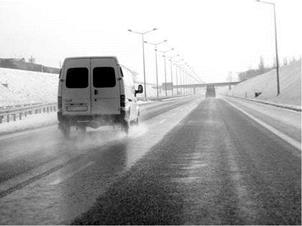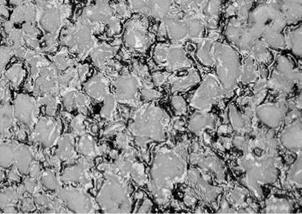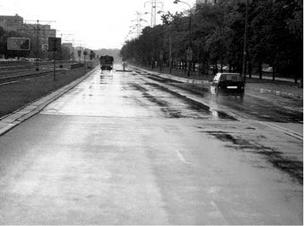ANTISPRAY AND LIGHT REFLECTION PROPERTIES
The safety provided by wearing course mixtures is of primary importance. The antispray properties of some mixes enhance safety by preventing the buildup of water mist behind vehicles. After rainfall (or melting snow), drops of water are raised up from a pavement by vehicle tires, especially the tires of large, fast-moving vehicles. Consequently, a certain amount of water in the form of mist remains suspended in the air surrounding fast-moving vehicles (Figure 12.7). Then it settles on windscreens, reducing visibility.
The generation of water mist and splash may be decreased by enabling quick water discharge after rainfall (through transverse cross-falls and having no ruts to hold water), a suitable depth of macrotexture, or a high content of air voids in a course. The last condition refers to open-graded friction course or porous asphalt. Water discharge through the whole thickness of a course is out of the question in the case of SMA. It is possible only through spaces among coarse aggregates sticking
|
figure 12.7 Water mist picked up by vehicles driving along a wet SMA pavement is reduced. (Photo courtesy of Krzysztof Blazejowski.) |
up from the surface of the course; hence, the proper SMA macrotexture is all important (Figure 12.8). Investigations conducted in the United States have proved that SMA courses reduce water splash in comparison with AC pavements; nevertheless, water remains longer on the SMA course where it can be held in the surface voids (Schmiedlin and Bischoff, 2002). The issues of SMA macrotexture were discussed in the Section 2.7 devoted to antiskidding properties.
Furthermore, macrotexture that reduces the water film on the surface of a wearing course is also of significance to the improvement in visibility of road marking after or during rainfall. Moreover, at night the light reflection (“glistening”) of vehicles travelling in the opposite direction is reduced. Figure 12.9 shows an image
|
FIGURE 12.8 Water discharge through small channels around SMA coarse aggregates. (Photo courtesy of Krzysztof Blazejowski.) |
|
FIGURE 12.9 Differences in pavement abilities to discharge water—the SMA course (near) and the old dense asphalt concrete (far). The light reflection off the wet SMA course is substantially less than that off the asphalt concrete course. (Photo courtesy of Krzysztof BlaZejowski.) |
of wearing course surfaces made of SMA and AC after rainfall and their light reflections (during the daytime). The difference in the way water is discharged as a result of the surface macrotexture is clearly noticeable.









Leave a reply